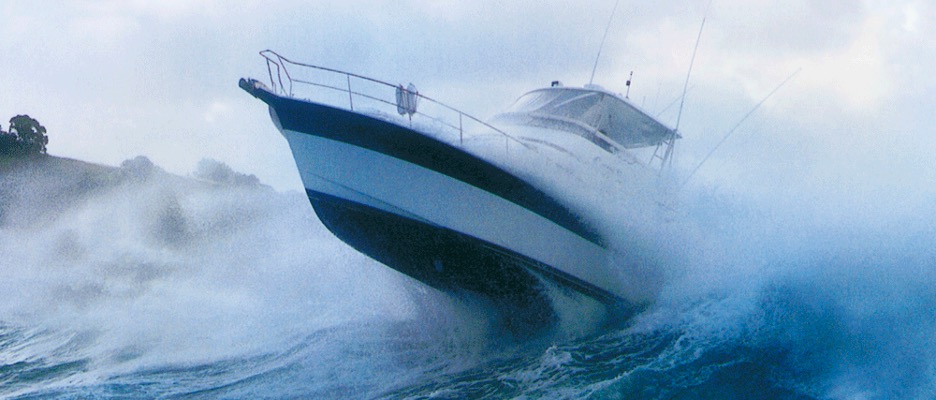Piloting In Head & Beam Seas — Part II
Head seas produce the most uncomfortable ride for any powerboat because the period of encounter with the waves is more rapid. The period of encounter is a combination of the boat’s speed and the speed of the waves, so you could reach a situation where the bow of the boat has not fully recovered from one wave before it has to lift to the next, so it gets out of step with the waves and starts to give a rough ride. Simply easing back on the throttles can make the ride more comfortable. Once you have found a comfortable speed, set the throttles and relax a little, but bear in mind that the larger than average waves can come along unexpectedly so your hand should never be too far from the throttles.
It is possible to drive the boat through head seas to make better progress by matching the speed much more closely to the conditions. To do this you adjust the throttle speed to each wave, watching out for the big ones that might approach from ahead. This type of driving requires considerable concentration, however, because you have to read every wave as it comes towards you and adjust the speed accordingly. In a diesel powered boat you may not always get the rapid response from the engines that you need in order to vary the speed quickly.
In a head sea the bow does tend to fly up into the air as it meets an oncoming wave, and if you drive too exuberantly the whole boat can fly out of the water. It is in these conditions that some of the other controls on the boat, such as trim tabs can be used to good effect. By putting the tabs down you will notice a significant drop in the bow. As with most aspects of power boating, a comfortable balance is what you are striving for when adjusting the trim tabs or power trim in the case of a sterndrive or outboard powered boat.
When you are running in a head sea and a large wave approaches, the tendency is to pull the throttles and reduce speed. Certainly there is a need to ease the throttles so that you don’t charge into a big wave at full speed, but the emphasis should be on the word ‘ease’ so that you drop the speed just a little and don’t pull the throttles right back so that the boat comes off the plane. By doing this there will be little change of attitude, but you will be at a more comfortable and resilient speed to meet the bigger wave and ride over it without any problems. Many of these comments apply equally to displacement boats running in a head sea and finding a comfortable speed is the secret of success. With a displacement boat or planing boat off the plane there is always a greater chance of the bow burying in the wave because the bow is more deeply immersed in these circumstances anyway and doesn’t have the same buoyancy as a boat up on the plane.

Handling In Beam Seas
In abeam sea the techniques for handling planing and displacement boats are very similar. In beam seas rolling is the problem, rather than pitching. Depending on the boat, the rolling may not be too uncomfortable and running in a beam sea can often be quite a comfortable way of making progress. Displacement boats tend to be more affected by beam seas than planing boats because the latter have much greater stability when travelling at higher speeds due to the dynamic effect of the hull on the water surface.
A displacement boat can roll quite uncomfortably in a beam sea and if the natural rolling period of the boat happens to synchronise with the waves, quite a dangerous situation can develop. There is a very simple remedy: alter course even just 5 or 10 degrees and you will probably find the motion of the boat changes dramatically. Therefore, in a beam sea, it is not usually a good idea to operate with the sea fully on the beam. Instead, alter course a few degrees, just to introduce a slight crossing element into the waves.
Apart from rolling, a beam sea can result in a fairly unpredictable motion, because at one moment you are running along the very uneven crest of a wave, and at the next making progress along its very uneven trough. The sheer unpredictability of the motion can be exhausting because it is so very difficult to anticipate. The part of the wave that usually causes the most trouble is the steeper leeward side because, with very little warning, you can often find yourself running on the crest of a wave and suddenly dropping down the steep face into the trough.
Operating in a beam sea is rarely dangerous unless the waves are breaking fairly heavily in something in Force 6 or better. If you can’t avoid it then you just have to drive for the conditions and only experience can help you decided what is a reasonable level of comfort for both you and the crew.
There are no particular techniques for operating in a beam sea. You can watch the seas ahead and you may be able to drive the boat around the bigger waves. You have the option of turning away from the sea and running from it or heading up into the wind and driving round the windward side of the wave. In beam seas as in other conditions, it is really just a question of matching your speed to the conditions. Certainly you have more freedom to adjust the speed in a beam sea because the stresses on the hull and crew will generally be much less than in a head sea.